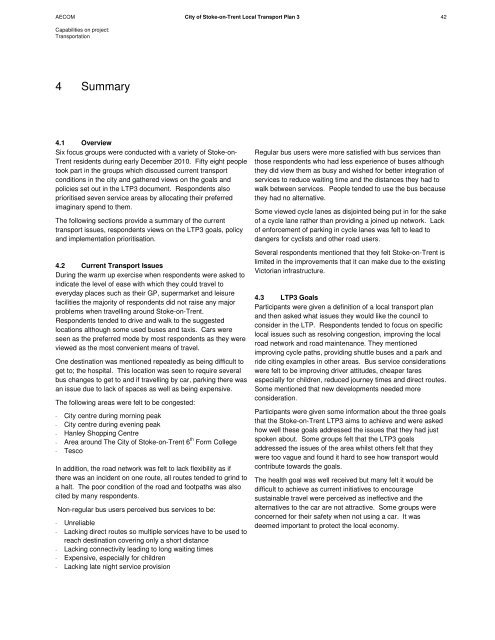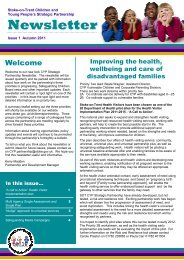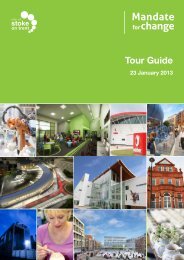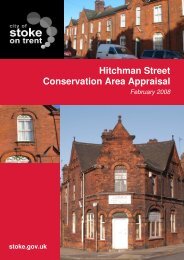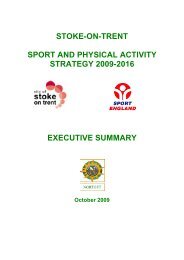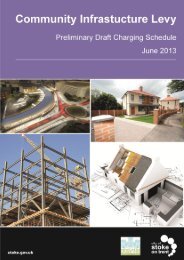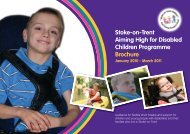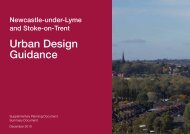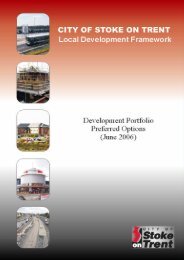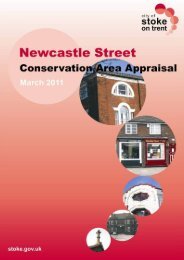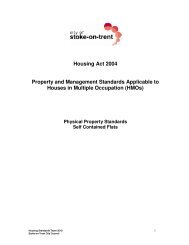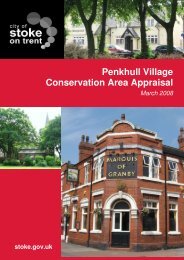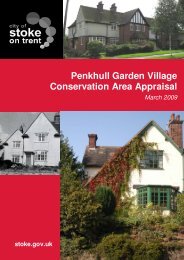City of Stoke-on-Trent Local Transport Plan 3 Focus Groups
City of Stoke-on-Trent Local Transport Plan 3 Focus Groups
City of Stoke-on-Trent Local Transport Plan 3 Focus Groups
- No tags were found...
You also want an ePaper? Increase the reach of your titles
YUMPU automatically turns print PDFs into web optimized ePapers that Google loves.
AECOM <str<strong>on</strong>g>City</str<strong>on</strong>g> <str<strong>on</strong>g>of</str<strong>on</strong>g> <str<strong>on</strong>g>Stoke</str<strong>on</strong>g>-<strong>on</strong>-<strong>Trent</strong> <strong>Local</strong> <strong>Transport</strong> <strong>Plan</strong> 3 42Capabilities <strong>on</strong> project:<strong>Transport</strong>ati<strong>on</strong>4 Summary4.1 OverviewSix focus groups were c<strong>on</strong>ducted with a variety <str<strong>on</strong>g>of</str<strong>on</strong>g> <str<strong>on</strong>g>Stoke</str<strong>on</strong>g>-<strong>on</strong>-<strong>Trent</strong> residents during early December 2010. Fifty eight peopletook part in the groups which discussed current transportc<strong>on</strong>diti<strong>on</strong>s in the city and gathered views <strong>on</strong> the goals andpolicies set out in the LTP3 document. Resp<strong>on</strong>dents alsoprioritised seven service areas by allocating their preferredimaginary spend to them.The following secti<strong>on</strong>s provide a summary <str<strong>on</strong>g>of</str<strong>on</strong>g> the currenttransport issues, resp<strong>on</strong>dents views <strong>on</strong> the LTP3 goals, policyand implementati<strong>on</strong> prioritisati<strong>on</strong>.4.2 Current <strong>Transport</strong> IssuesDuring the warm up exercise when resp<strong>on</strong>dents were asked toindicate the level <str<strong>on</strong>g>of</str<strong>on</strong>g> ease with which they could travel toeveryday places such as their GP, supermarket and leisurefacilities the majority <str<strong>on</strong>g>of</str<strong>on</strong>g> resp<strong>on</strong>dents did not raise any majorproblems when travelling around <str<strong>on</strong>g>Stoke</str<strong>on</strong>g>-<strong>on</strong>-<strong>Trent</strong>.Resp<strong>on</strong>dents tended to drive and walk to the suggestedlocati<strong>on</strong>s although some used buses and taxis. Cars wereseen as the preferred mode by most resp<strong>on</strong>dents as they wereviewed as the most c<strong>on</strong>venient means <str<strong>on</strong>g>of</str<strong>on</strong>g> travel.One destinati<strong>on</strong> was menti<strong>on</strong>ed repeatedly as being difficult toget to; the hospital. This locati<strong>on</strong> was seen to require severalbus changes to get to and if travelling by car, parking there wasan issue due to lack <str<strong>on</strong>g>of</str<strong>on</strong>g> spaces as well as being expensive.The following areas were felt to be c<strong>on</strong>gested:- <str<strong>on</strong>g>City</str<strong>on</strong>g> centre during morning peak- <str<strong>on</strong>g>City</str<strong>on</strong>g> centre during evening peak- Hanley Shopping Centre- Area around The <str<strong>on</strong>g>City</str<strong>on</strong>g> <str<strong>on</strong>g>of</str<strong>on</strong>g> <str<strong>on</strong>g>Stoke</str<strong>on</strong>g>-<strong>on</strong>-<strong>Trent</strong> 6 th Form College- TescoIn additi<strong>on</strong>, the road network was felt to lack flexibility as ifthere was an incident <strong>on</strong> <strong>on</strong>e route, all routes tended to grind toa halt. The poor c<strong>on</strong>diti<strong>on</strong> <str<strong>on</strong>g>of</str<strong>on</strong>g> the road and footpaths was alsocited by many resp<strong>on</strong>dents.N<strong>on</strong>-regular bus users perceived bus services to be:- Unreliable- Lacking direct routes so multiple services have to be used toreach destinati<strong>on</strong> covering <strong>on</strong>ly a short distance- Lacking c<strong>on</strong>nectivity leading to l<strong>on</strong>g waiting times- Expensive, especially for children- Lacking late night service provisi<strong>on</strong>Regular bus users were more satisfied with bus services thanthose resp<strong>on</strong>dents who had less experience <str<strong>on</strong>g>of</str<strong>on</strong>g> buses althoughthey did view them as busy and wished for better integrati<strong>on</strong> <str<strong>on</strong>g>of</str<strong>on</strong>g>services to reduce waiting time and the distances they had towalk between services. People tended to use the bus becausethey had no alternative.Some viewed cycle lanes as disjointed being put in for the sake<str<strong>on</strong>g>of</str<strong>on</strong>g> a cycle lane rather than providing a joined up network. Lack<str<strong>on</strong>g>of</str<strong>on</strong>g> enforcement <str<strong>on</strong>g>of</str<strong>on</strong>g> parking in cycle lanes was felt to lead todangers for cyclists and other road users.Several resp<strong>on</strong>dents menti<strong>on</strong>ed that they felt <str<strong>on</strong>g>Stoke</str<strong>on</strong>g>-<strong>on</strong>-<strong>Trent</strong> islimited in the improvements that it can make due to the existingVictorian infrastructure.4.3 LTP3 GoalsParticipants were given a definiti<strong>on</strong> <str<strong>on</strong>g>of</str<strong>on</strong>g> a local transport planand then asked what issues they would like the council toc<strong>on</strong>sider in the LTP. Resp<strong>on</strong>dents tended to focus <strong>on</strong> specificlocal issues such as resolving c<strong>on</strong>gesti<strong>on</strong>, improving the localroad network and road maintenance. They menti<strong>on</strong>edimproving cycle paths, providing shuttle buses and a park andride citing examples in other areas. Bus service c<strong>on</strong>siderati<strong>on</strong>swere felt to be improving driver attitudes, cheaper faresespecially for children, reduced journey times and direct routes.Some menti<strong>on</strong>ed that new developments needed morec<strong>on</strong>siderati<strong>on</strong>.Participants were given some informati<strong>on</strong> about the three goalsthat the <str<strong>on</strong>g>Stoke</str<strong>on</strong>g>-<strong>on</strong>-<strong>Trent</strong> LTP3 aims to achieve and were askedhow well these goals addressed the issues that they had justspoken about. Some groups felt that the LTP3 goalsaddressed the issues <str<strong>on</strong>g>of</str<strong>on</strong>g> the area whilst others felt that theywere too vague and found it hard to see how transport wouldc<strong>on</strong>tribute towards the goals.The health goal was well received but many felt it would bedifficult to achieve as current initiatives to encouragesustainable travel were perceived as ineffective and thealternatives to the car are not attractive. Some groups werec<strong>on</strong>cerned for their safety when not using a car. It wasdeemed important to protect the local ec<strong>on</strong>omy.


